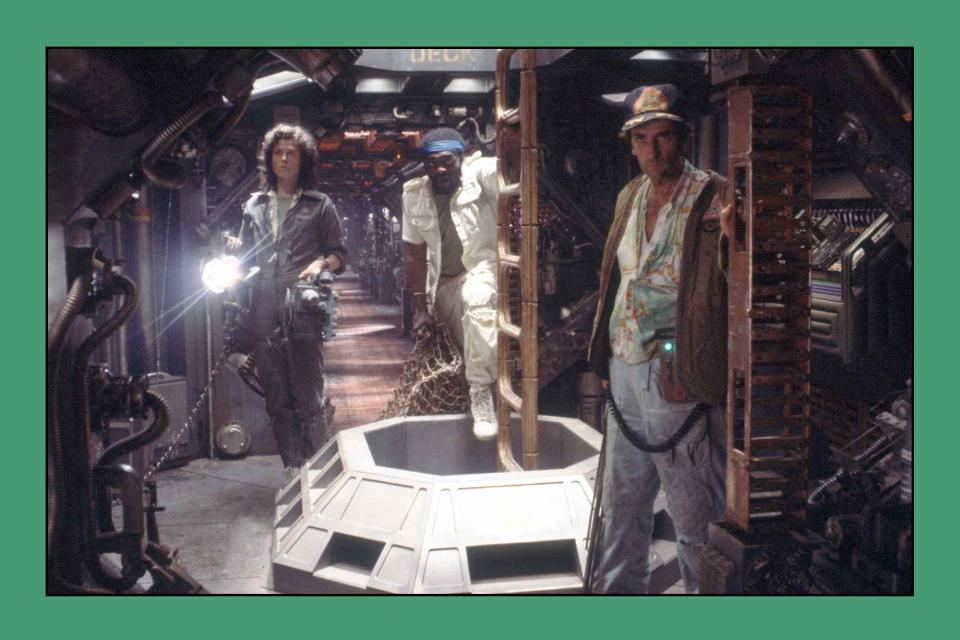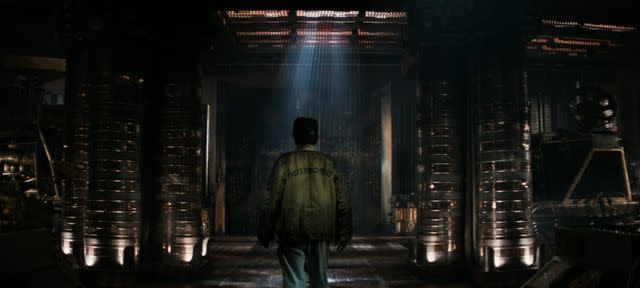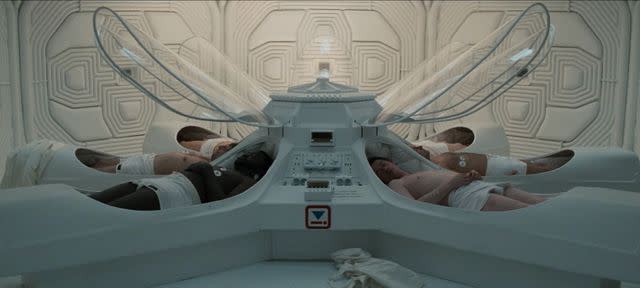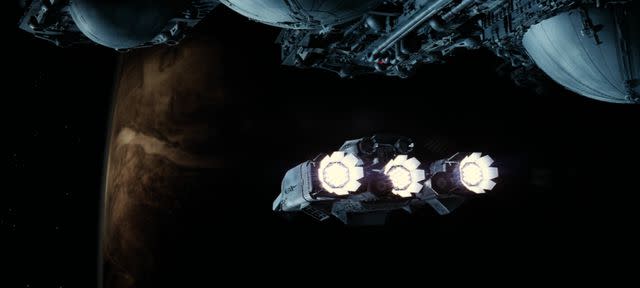Where was “Alien” filmed? 10 locations from the classic sci-fi film and its sequels
Entertainment Weekly looks back at the franchise 45 years later.

Sunset Boulevard/Corbis via Getty
Ridley Scott’s classic sci-fi horror Alien (1979) takes place in deep space, light years from Earth, on the starship Nostromo as it picks up what the crew thinks is a distress signal from a nearby moon, LV-426. By the time Ellen Ripley (Sigourney Weaver) figures out the signal is actually a warning, Kane (John Hurt) is attacked by an unknown lifeform. Ignoring Ripley’s quarantine protests, Dallas (Tom Skerritt) and Lambert (Veronica Cartwright) bring a facehugged Kane back on board. Facehugger eventually turns into a chest-burster and escapes into the murky industrial shadows of the ship.
Join Entertainment Weekly as we explore the ins and outs of that ship. Here’s where Alien was filmed, plus some insight into the sequels.
Shepperton Studios (Shepperton, England)
Of course, this primal cat-and-mouse between the humans and the horrifying xenomorph they accidentally unleashed was not actually filmed in outer space. In fact, nearly all of production took place on enormous soundstages provided by Shepperton Studios near London, in addition to miniature work finalized at Bray Studios in Windsor, England.
Charles de Lauzirika’s behind-the-scenes documentary The Beast Within: The Making of Alien (2003) details how over 200 artists, engineers, and other technical specialists constructed three full-size sets at Shepperton. Those sets included the surface of the mysterious planetoid LV-426, the seemingly abandoned alien spaceship, and the interiors of the Nostromo itself.

20th Century Studios
Tons of raw materials like glass, sand, rocks, and more arrived at Shepperton and crafted the moon’s surface. Since this area was indoors and it was impossible to properly cool the studios during a heat wave, actors and their doubles kept nearly fainting from the heat to the point that they had nurses on hand. As it turns out, Scott had his pre-teen sons stand in for crew members for several scenes to make the externals of the Nostromo look larger (the two boys did, in fact, pass out from the temperature in their suits).
Art director Roger Christian used tricks he learned from designing Star Wars (1977) sets to repurpose scrapped aircrafts and bomber jets to create the Nostromo’s underdecks, giving the ship the junkyard aesthetic that made its so-called space truckers feel right at home.
The internal sets of the three Nostromo decks were essentially one huge, labyrinthine piece that the actors had to puzzle through from hallway to hallway. While adding to the claustrophobia of the sets, working on these soundstages ended up being a bit like theater. In the cases of many cast members — including Weaver, Hurt, Ian Holm, and Yaphet Kotto — the theater was how they began their careers as actors.

20th Century Studios
There’s a certain cognitive dissonance to the notion of such lo-fi tech being used to create a spaceship hundreds of years in the future. But the intimate, practical design of the interiors — devised with logical precision by concept artist Ron Cobb — allowed Alien to feel truly lived-in.
“Everything was so claustrophobic on that set,” Cartwright said in de Lauzirika’s documentary. “You walked in, and there’s the engine room… but connected to that was the corridor, connected to that was the cafeteria, connected to that was the hospital. It was all connected, the ship. Once you were on, you were on.”
On the opposite end of the design spectrum was steampunk gothic artist H.R. Giger, who created all of the otherworldly ideas, including the xenomorphs, their ships, their moon, and their eggs. Giger’s fleshy, organic aesthetics extended even to the desiccated “space jockey” skeleton and the internal organ-esque metals and alloys of the derelict alien craft, which looks and feels like a full-fledged biomechanical organism.
Bray Studios (Windsor, England)
As principal filming took place at Shepperton, art director Les Dilley was across the English countryside at Bray Studios creating miniatures of the moon, the Nostromo, and the creature. His miniatures were essential for adding detail to the sets, plus the various external and establishing shots like the Nostromo gliding through space.

20th Century Studios
Pinewood Studios (Iver, England)
James Cameron’s sequel Aliens (1986) was also filmed largely on soundstages at London’s Pinewood Studios. This time around, the ship is the Sulaco, but the alien moon has been transformed into a terraforming colony. The newly envisioned LV-426 — its living quarters, medical facilities, cargo elevators, factory-like operations, and more — was built and brought to life at Pinewood. But there were a few exceptions…
Acton Lane Power Station (London, England)
Cameron found the decommissioned Acton Lane Power Station in west London for exterior shots of the colony’s atmosphere processing plant. The station also served an even more important purpose: It was where Cameron and his team created the xenomorphs’ famous cocoon nest.
Blast Beach (Seaham, England)
Six years later, the franchise returned to Pinewood Studios for David Fincher’s Alien 3 (1992). But a few key moments were captured in the great outdoors, specifically Blast Beach in Seaham, on northern England’s Durham Coast. Because the beach had essentially become a waste depository from the nearby Seaham Harbour Blast Furnace, it made for perfectly barren surroundings of the prison planet Fiorina 161.
20th Century Fox Studios (Century City, California)
Jean-Pierre Jeunet’s fourth installment, Alien: Resurrection (1997), was the first and only entry in the franchise to be filmed in the United States, specifically at 20th Century Fox Studios with some post-production in Canada. The expansive sets at Fox housed the interiors of both of the film’s ships — yes, including everything in the underwater chase scene.
Milford Sound, Fiordland National Park (Fiordland, New Zealand)
Production for the sixth film in the series, Alien: Covenant (2017), took place on location in New Zealand, plus some soundstage work at Australia’s Fox Studios near Sydney. The movie’s first key sequence is the Covenant crew following a transmission on a habitable planet, with Milford Sound’s mountains and waterfalls serving as the perfect backdrop to an inevitably doomed mission.
Dettifoss Waterfalls, Vatnajökull National Park (Iceland)
When Scott first returned to the Alien franchise with Prometheus (2012), this time with a much larger budget, he did a great deal of filming on location in Iceland, Scotland, and Jordan. Prometheus’ opening scene, featuring the ancient Engineer consuming and releasing the toxic genetic goo, was filmed at Dettifoss Waterfalls in the remote Vatnajökull National Park of northeast Iceland.
Old Man of Storr (Isle of Skye, Scotland)
The cave where Elizabeth Shaw (Noomi Rapace) and her partner Charlie Holloway (Logan Marshall-Green) discover drawings they interpret as an invitation from the Engineers to find them is called the Old Man of Storr, located on the picturesque Isle of Skye, Scotland.
Wadi Rum Nature Preserve (Jordan) and Mount Hekla (Iceland)
When Shaw and her colleagues arrive on the moon LV-223, the desert scenery is from the Wadi Rum Nature Preserve in Jordan coupled with backdrops from Iceland’s volcano Mount Hekla, where the final action takes place. The film’s interior shots were all filmed on soundstages in Pinewood Studios, which subsumed the original Alien filming locations within Shepperton Studios back in 2001, bringing Scott full circle in the iconic series he launched.
Read the original article on Entertainment Weekly.


